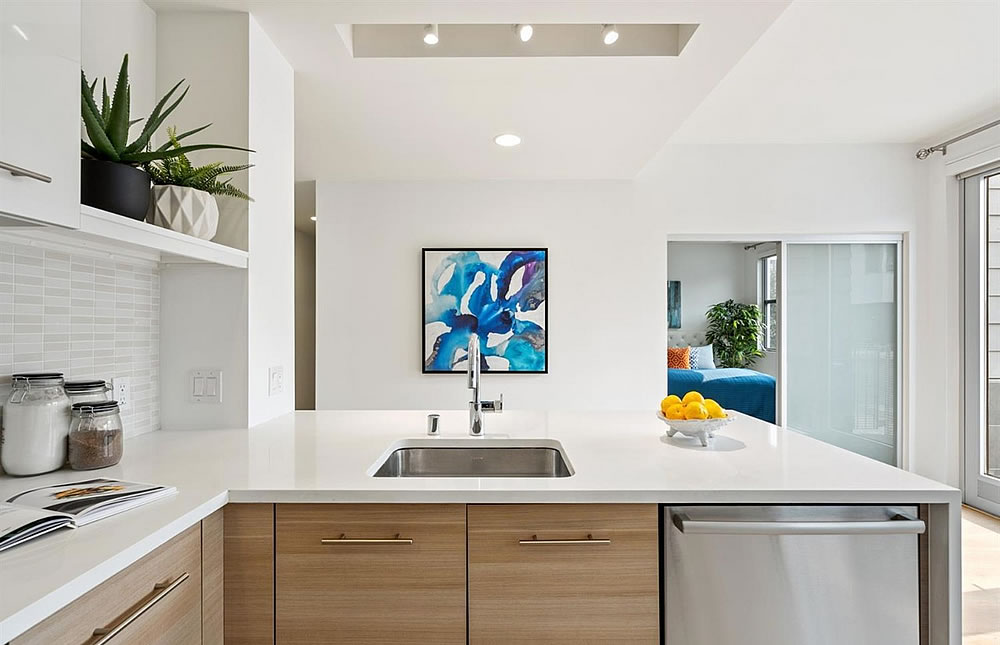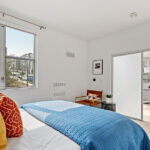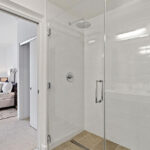Marketed as a “fantastic opportunity to get in on the new and ultra chic community of The Shipyard,” the two-bedroom, two-bath unit #216 at 451 Donahue Street, which was purchased pre-construction from Lennar for $560,800 in 2014, was flipped for $780,000 in June of 2016, shortly after the unit was completed.
The 912-square-foot unit features a modern open kitchen with wide-plank hardwood floors, an abundance of natural light, a designated parking space in the Merchant Building’s garage and HOA dues of $510 per month.
And having returned to the market priced at $788,000 in February of 2019, re-listed for $695,000 this past August and then reduced to $649,000 in September, the re-sale of 451 Donahue Street #216 has now closed escrow with a contract price of $623,000, down 20.1 percent from the second quarter of 2016 on an apples-to-apples basis.
UPDATE: We’ve added the pre-construction contract price for the unit for additional context and clarification. And to be clear, two-bedroom townhouse units in Lennar’s Shipyard development were priced starting at $658,700 back in 2014.










Ground floor unit.
Apparently the ground floor was worth 20% more in 2016.
“Making access to your new condo very easy,” per its listing in 2016 (and without a required elevator ride, which some might view as a selling point over the past year).
I think it is criminal to bake elevator costs into HOA fees for ground floor or 1st floor units unless building has garage access from them. In all other cases elevator maintenance should be separate passthrough for second floor units and higher only.
Does anyone have any information on owners? My best guess. Had a kid or two and buying a 1.75m home in Lamorinda area.
I detest this unit.
The bedroom square footage is *way* too high and should have been allocated to the living/dining space which is not sufficient. Perhaps it was a quirk of the specific unit/location within the building that it had to be done this way.
Too high of an HOA, for little to no on-site amenities.
Limited to no walkability, high crime, and historically polluted area.
If you could create your own little oasis (nice unit, nice amenities) I could be convinced but this is bleh.
Agreed, a $510 HOA is ridiculous. But then I apparently am out of sync with the market; I don’t understand the appeal of having access to (and hence paying for) all sorts of common area meeting rooms, rec rooms, BBQs, etc. I’d rather have additional square footage in my unit (and pay for it one-time up-front).
It’s probably an 80/20 rule situation. 20% of the residents make great use of the common space and actually get a bargain. The other 80% pay and get limited value. In particular, from what I’ve observed, the common lounges or BBQ spaces are empty nearly 100% of the time. It’s for show only.
The HOA dues are actually below average for a newer construction two-bedroom unit. And in terms of amenities, there is an on-site gym, secured bike room and rather nice roof deck (with views).
Whoever paid $855 psf to live on a toxic waste dump in 2016 is [a fool]. Even at the new price of $683 psf, I don’t see the value. $600 psf seems like fair market value.
The average sale price for Shipyard units over the past 12 months has actually been a little over $700 per square foot.
Sure. $850 in 2016, $700 in 2020 … and my prediction is $600 in 2021. Skate to where the puck is going, not where it is right now.
But…but…it’s ultra chic!!
“…ultra chic…”
That is a stretch. The place is a desert.
Terrible place to live and a stupid investment.
views to die for…
When are realtors going to stop stretching photos and using funky lenses to make things look larger than they are? (I know, the answer is “never.”) But I get so tired of photos with (seemingly) six-foot-wide dishwashers and the like. It makes me distrust every single photo when even one is intentionally distorted.
I walked through a couple of these units, out of curiosity, when they were first built. They seemed okay if you were willing to put up with the remote location. But that was before it came out that the land is probably still toxic and further development there kind of ground to a halt. If the entire project ever gets built out, complete with stores, etc., it may become more of a neighborhood. For now it feels to me like it’s at the end of the earth.
Does anybody know if the problems with unabated radiation, etc. in the soil extend to the existing Shipyard units?
It would be easy to define some basic rules for real estate photography: ban cloning and extreme perspective correction (causes “stretching”) for example. If only there were an industry organization that had a REAL interest TO pRomote honeSty in listings.
As for radioactivity left over from Project Crossroads, I’d expect that conditions are safe now so long as there isn’t extensive excavation that could bring radioactive dust into the air. Even that problem was probably addressed otherwise the builders would have been exposed during the construction phase.
Who’s to say the builders WEREN’T exposed during the construction phase? The damage done by the kind of radiation exposure we’re (maybe) talking about may take years or decades to become apparent.
I have no idea what they did to abate the problem, how deep they excavated and removed soil, etc. But we know that the contractor for the abatement apparently falsified tests left and right, or at least that is alleged. So it wouldn’t be high on my list of places to buy.
These photos look realistic; certainly not “stretched.” Just very high quality and professional. Unless you want to take pictures of just parts of rooms, you need a wide-angle lens. Nothing “funky” about that, just a normal lens-type that’s been around for ages.
Some of the photos are definitely stretched. Take a look at the 4th photo in the gallery above and see the aspect ratio of the leftmost electrical plate. This is the result of a trapezoidal perspective correction, not a wide angle lens.
They need to be a lot more transparent about addressing the underlying land contamination before I would want to buy there.
How hard is it to have a hall separating the living room and kitchen from the bedroom? At the Madelon many units feature front doors crammed into the kitchen. Its like the notorious funkiness of old-timey subdivided apartments is now baked into the design.
This Merchant building at the Shipyard has some of the worst layouts of all the Shipyard condo buildings. Small kitchens, non-existent dining rooms, bedrooms immediately off the common areas. Functional layouts was probably the last priority in the design phase. Also, this building has many issues due to poor design and mechanical layouts. Fortunately all the other buildings at the Shipyard are much better in terms of unit and overall building mechanical layout.
As a former tenant at the shipyard, I would be very reluctant to buy a home in that location. Years ago, shortly before vacating our studios, there was a spontaneous combustion underground fire on the shipyard property that burned for many months, even after pumping water into the ground vents in an attempt to extinguish it. Testing of the smoke showed a multitude of serious industrial contaminates, including Mercury, lead etc.
The last people you want to believe when purchasing a home are the ones trying to sell it to you. Do your own research. “Super chic” indeed…
Curious what building were you in? This is the first time I’m hearing about this and I’ve had friends live there and frequently visited since 2015.
UPDATE: We’ve since added the pre-construction contract price for the unit for additional context above. And to be clear, two-bedroom townhouse units in Lennar’s Shipyard development were priced starting at $658,700 back in 2014.
Lots of naysaying here. Two beds, two baths, in San Francisco, new construction, for $623k? Great work by the buyers. This neighborhood will grow. It feels separate from the surrounding run down areas. I think all these units have a dedicated parking place, right? No mention in the article but I recall stacked lifts in the building I saw. These buyers will make money and have a nice place for someone to live.
Have you completely ignored the history and issues regarding soil contamination here? Neighborhood Activist’s 2nd paragraph sums up things pretty nicely.
Obviously a $700k range place in SF is not going to be top notch. But what this does illustrate is how wide from low end to high end the range of price declines is.
This one ($623k) down 20% from mid-2016.
This one ($4.6M) down 13.2% from Jan 2018.
This one ($4.2M) down 20% from Aug 2018.
You can pick at flaws in low end properties to try and rationalize price drops and claim that the rich don’t care or “Bigger prices tend to lose more since there are less buyers. ” to rationalize high end price drops. But when both ends are dropping you’ve got to realize that broader market forces are at work.